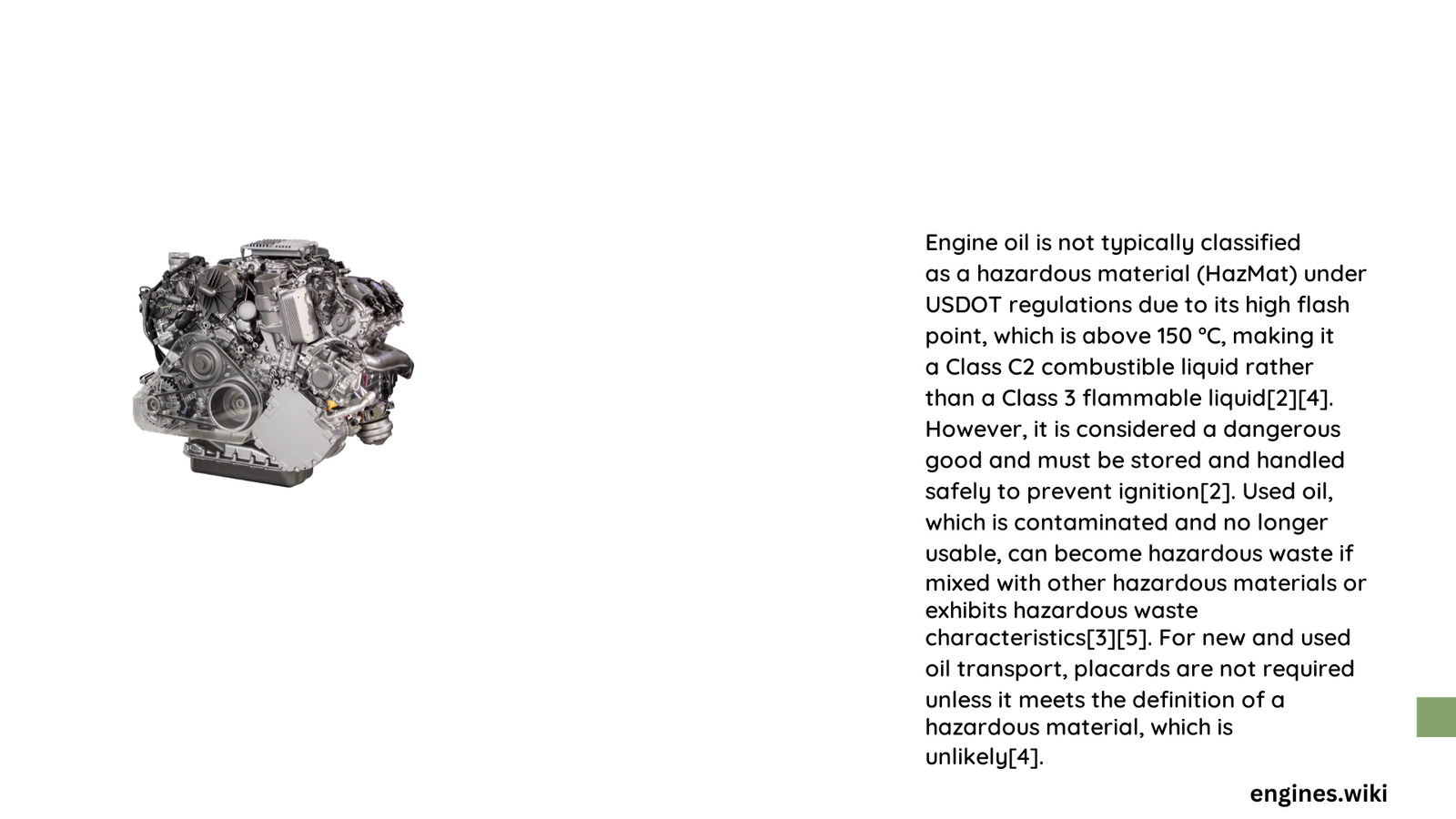Engine oil occupies a complex regulatory space regarding hazardous material classification. While typically not considered a hazmat substance during standard transportation, specific conditions can transform its status. Understanding the nuanced regulations surrounding engine oil’s classification is crucial for automotive professionals, environmental compliance officers, and vehicle maintenance personnel.\n\n## What Determines Engine Oil’s Hazardous Material Status?\n\n### Are Standard Engine Oils Considered Hazardous?\nEngine oils are generally not classified as hazardous materials under most transportation and workplace regulations. However, several critical factors influence this classification:\n\n| Condition | Hazmat Potential | Explanation |\n|———–|—————–|————-|\n| New, Unopened Oil | Low Risk | Meets standard safety requirements |\n| Used/Contaminated Oil | Higher Risk | Contains combustion byproducts |\n| Bulk Shipment Quantities | Potential Hazmat | Exceeds standard transportation limits |\n\n### What Regulatory Standards Apply?\nMultiple agencies provide guidance on engine oil’s hazardous material classification:\n\n1. Department of Transportation (DOT)\n – Defines transportation safety standards\n – Provides exemption for consumer-quantity shipments\n\n2. Occupational Safety and Health Administration (OSHA)\n – Establishes workplace handling guidelines\n – Requires safety data sheet documentation\n\n3. Environmental Protection Agency (EPA)\n – Regulates disposal and environmental impact\n – Monitors potential contamination risks\n\n## How Does Contamination Affect Hazmat Classification?\n\n### What Makes Used Engine Oil Hazardous?\nUsed motor oil transforms from a relatively inert substance to a potential hazardous material through contamination:\n\n- Contains heavy metal particles\n- Includes combustion byproducts\n- Absorbs potential toxic chemicals during engine operation\n\n### What Are Disposal Requirements?\nProper disposal is critical to managing potential hazardous characteristics:\n\n- Recycling Centers: Mandatory for used oil\n- Documentation: Tracking oil origin and disposal\n- Containment: Preventing environmental contamination\n\n## What Are Environmental Risks?\n\n### Can Improper Oil Disposal Cause Ecological Damage?\nImproperly disposed engine oil poses significant environmental threats:\n\n- Soil Contamination: Disrupts microorganism ecosystems\n- Water Pollution: Threatens aquatic life\n- Long-term Environmental Impact: Persistent chemical contamination\n\n## Best Practices for Handling Engine Oil\n\n### How Should Professionals Manage Engine Oil?\n1. Use appropriate personal protective equipment\n2. Follow manufacturer safety guidelines\n3. Maintain accurate disposal documentation\n4. Utilize certified recycling facilities\n5. Implement spill prevention strategies\n\n## Conclusion\nWhile engine oil is not universally classified as a hazardous material, context and condition significantly influence its potential risks. Professionals must remain vigilant, follow regulatory guidelines, and prioritize environmental safety.\n\n### Reference:\n- EPA Used Oil Management Standards\n- DOT Hazardous Materials Regulations\n- OSHA Chemical Hazard Communication

